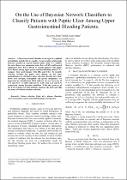| dc.contributor.author | Nazziwa, Aisha | |
| dc.contributor.author | Mohd, Bakri Adam | |
| dc.date.accessioned | 2022-12-27T10:49:32Z | |
| dc.date.available | 2022-12-27T10:49:32Z | |
| dc.date.issued | 2012 | |
| dc.identifier.uri | http://ir.iuiu.ac.ug/xmlui/handle/20.500.12309/821 | |
| dc.description | A Bayesian network classifier is one type of graphical probabilistic models that is capable of representing relationship between variables in a given domain under study | en_US |
| dc.description.abstract | A Bayesian network classifier is one type of graphical probabilistic models that is capable of representing relationship between variables in a given domain under study. We consider the naïve Bayes, tree augmented naïve Bayes (TAN) and boosted augmented naïve Bayes (BAN) to classify patients with peptic ulcer disease among upper gastro intestinal bleeding patients. We compare their performance with IBk and C4.5. To identify relevant variables for peptic ulcer disease, we use some methodologies for attributes subset selection. Results show that, blood urea nitrogen, hemoglobin and gastric malignancy are important for classification. BAN achieves the best accuracy of and AUC of (0.81) followed by TAN with 72.4 and 0.76 respectively among Bayesian classifiers. While the accuracy of the TAN is improved with attribute selection, the BAN and IBK are better off without attribute selection. | en_US |
| dc.language.iso | en | en_US |
| dc.publisher | IEEE | en_US |
| dc.subject | Feature selection | en_US |
| dc.subject | Peptic ulcer disease | en_US |
| dc.subject | Bayesian network classifiers | en_US |
| dc.subject | Gastro intestinal bleeding | en_US |
| dc.subject | Classification | en_US |
| dc.title | On the Use of Bayesian Network Classifiers to Classify Patients with Peptic Ulcer Among Upper Gastrointestinal Bleeding Patients | en_US |
| dc.type | Article | en_US |

